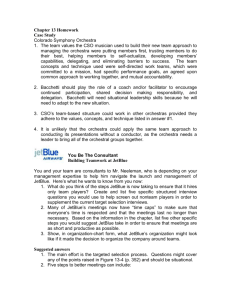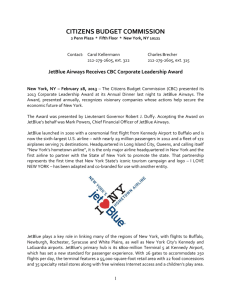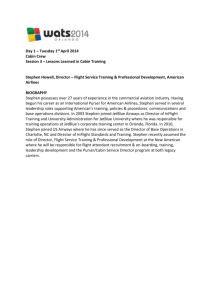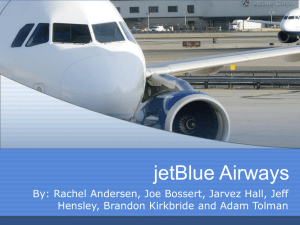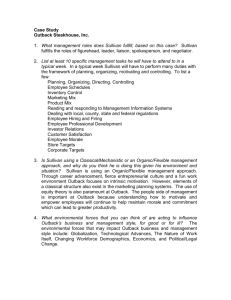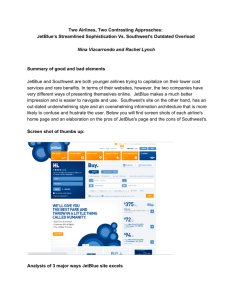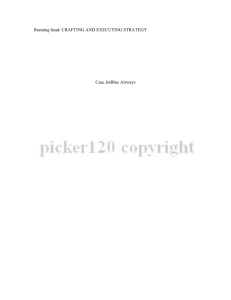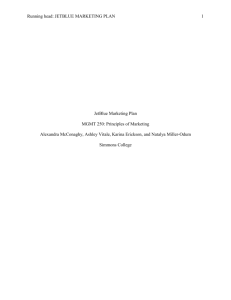JetBluePP
advertisement
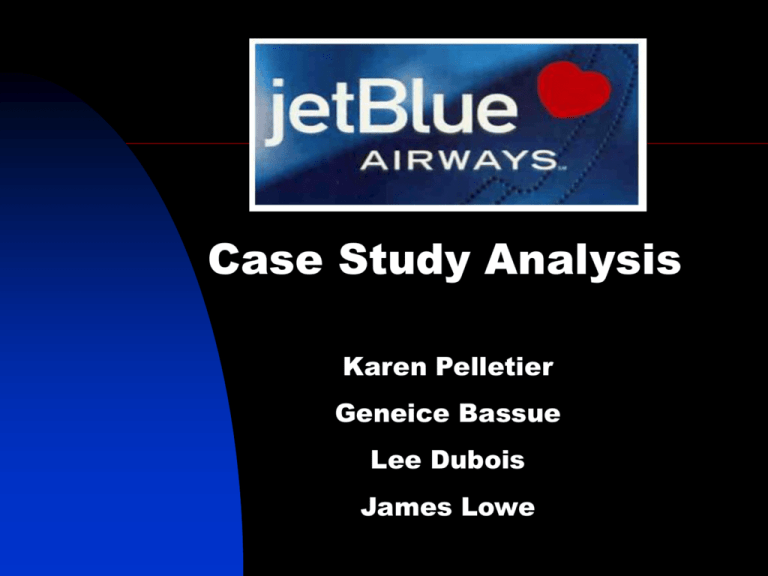
Case Study Analysis Karen Pelletier Geneice Bassue Lee Dubois James Lowe History of the Company Incorporated in 1998 in Delaware, commenced service in 2000 primary base of operations at JFK in New York. 2002 - Operated 108 flights per day -- 52 daily flights between JFK and FL -- 26 daily flights between JFK and upstate NY -- 18 daily flights between JFK and the western US. History of the Company 2002 - Stock trading just below $20 2004 - Revenues of $1.22 billion. July 2005 - 52 week high was $26.40. Mission Statement Jet Blue’s mission is to be the leading low-fare, lowcost passenger airline offering high quality customer service to underserved markets and customer who are looking for the best value in their flight. We have the newest most advanced planes that are reliable, fuel efficient, utilizes paperless cockpit technology, live in-flight satellite TV and security cameras. Our philosophy is to give customers the best price value for their ticket, offering things our competitors don’t offer. At JetBlue we feel that hiring educated employees that are highly motivated and well trained will provide a better experience to the customers. We feel that our high-value, high quality service philosophy will lead the way to our becoming the number one in the industry. Vision Statement At JetBlue our goal is to provide the best, most affordable flight experience of any air carrier while providing superior service. JetBlue’s Goals “The company’s goal has been to establish itself as a leading low-fare, lowcost passenger airline by offering customers high-quality customer service and differentiated products. “ They focus on serving underserved markets and large metropolitan areas that have high average fares with a diversified geographical flight schedule that includes both short and long haul routes. Issues at Hand Rising Fuel Costs Labor Unions Lots of competition Not-well-known airline. Cutting costs while increasing revenues and profits. Rankings #6 in World’s Top Low Cost Carriers by Net Profit, 2004 #4 in World’s Top Low Cost Carriers by Load Factor, 2005 #4 in Most Profitable Airlines, 2004 ($47.5 million) #3 in Most Admired U.S. Airlines, 2006 External Audit Opportunities: Increasing demand for air travel. Untapped international market. All other airlines that have much higher fares. Other airlines who have been hurting since 911 and heading for Chapter 11. Increasing use of the Internet. Potential use of luggage-tracking technology. External Audit Threats: Many airlines including JetBlue face union labor contracts. Unions can strike whenever no agreements are made. Fuel costs are high and are a HUGE part of airline expenses. Breakeven load factor is rising. Higher security required at airports is causing higher fees on tickets and more customer dissatisfaction. Competitive Profile Matrix External Factor Evaluation Matrix Balance Sheet Income Statement Internal Audit Strengths: Low fares compared to other airlines. Superior customer service. Low labor wages that save them money. More efficient and reliable planes. Only airline to offer live TV in-flight. High commitment to hiring better employees. Through their current workings, they are able to build good brand loyalty. Internal Audit Weaknesses: Low fares could mean less money being made, less profits. Much higher average airborne time and higher % of diverted flights. Smaller and more unheard of than any airline. Fuel consumption, as a % of expenses, is rising rapidly. Very low percentage of full-time employees. Extra bells and whistles could cost company $$. Internal Factor Evaluation Matrix Financial Ratios Current Ratio --> 1.06 Quick Ratio --> 1.08 Accounts Rec. Turnover --> 33.08 Debt to Equity --> 2.04 GPM --> 0.37 Return on Assets --> 0.02 EPS --> 45.55 LT Debt to Equity --> 0.65 Interest Earned --> 2.53 SWOT Matrix SWOT Matrix SPACE Matrix SPACE Matrix Quantitative Strategic Planning Matrix Alternative Strategies Fly Internationally Extend flights to major hubs in Europe to start off, then as that takes off, offer flights to Asia, Australia, etc. This is an example of Market Development Cost: $100,000,000 for 3 planes, fuel for a year and maintenance costs. Alternative Strategies Increase Advertising and Expand to Other Media JetBlue could advertise on TV, Radio, and Online to boost revenues and popularity of the airline. This is an example of Market Penetration. Cost: About $4,000,000. Alternative Strategies Build Partnership Travel Website. Build a website where users can look up information about different travel destinations, find hotels, restaurants, hot spots, etc, and book a flight through JetBlue all while comparing prices from other airlines. This is an example of Related Diversification. Cost: About $30,000 to start off, then about $60,000 per year to maintain (for a small site). Recommendations for JetBlue JetBlue should implement these strategies in three stages. -Introductory Phase – Implement new advertising campaigns to get JetBlue’s name known. - Middle Phase – Start the travel website to help attract new people to JetBlue, get them to fly, and build a reputation. - End Phase – Start flying internationally. Once customers know JetBlue and JetBlue gains a reputation for high quality and low prices, people will want to fly them no matter where they go. References http://www.aa.com/content/images/amrcorp/amrcor p2004ar.pdf http://www.aa.com/content/images/amrcorp/amrcor p2004ar.pdf http://www.tampaairport.com/about/facts/activity_re ports/2005/marketshare_jan2005.pdf http://library.corporateir.net/library/13/131/131045/items/211507/200410k .pdf Recommendations for JetBlue
